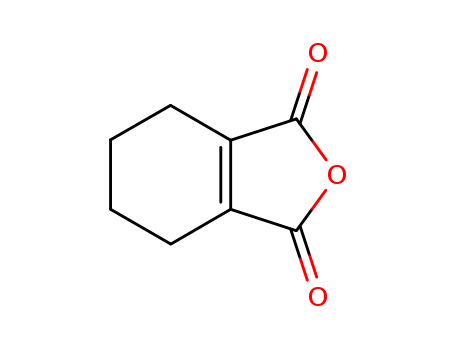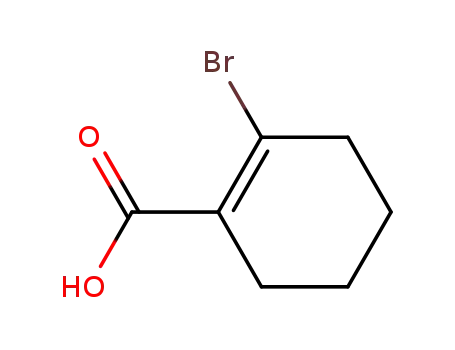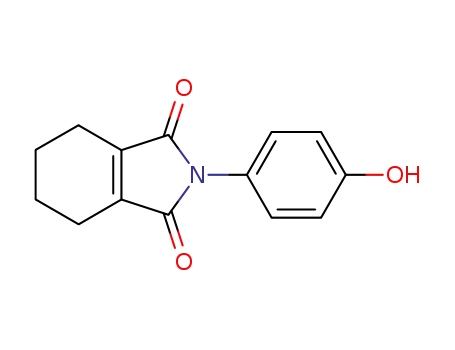Your Location:Home >Products >Acid Anhydrides >2426-02-0


Product Details
Chemical Properties
White to cream crystalline powder
Uses
3,4,5,6-Tetrahydrophthalic Anhydride is useful in the synthesis and biological evaluation of 6-hydroxypyridazinone benzisoxazoles as an atypical antipsychotics.
InChI:InChI=1/C8H8O3/c9-7-5-3-1-2-4-6(5)8(10)11-7/h1,3,5-6H,2,4H2
Protoporphyrinogen oxidase (protox), the last common enzyme in heme and chlorophyll biosynthesis, is the target of several classes of herbicides acting as inhibitors in both plants and mammals. N-(4-Chloro-2-fluoro-5- (propargyloxy)phenyl)-3,4,5,6-tetrahydrophthalimide (a potent protox inhibitor referred to as THP) was synthesized as a candidate radioligand ([3H]-THP) by selective catalytic reduction of 3,6-dihydrophthalic anhydride (DHPA) with tritium gas followed by condensation in 45% yield with 4-chloro- 2-fluoro-5-(propargyloxy)aniline. Insertion of tritium at the 3 and 6 carbons of DHPA as well as the expected 4 and 5 carbons resulted in high specific activity [3H]THP (92 Ci/mmol). This radioligand undergoes rapid, specific, saturable, and reversible binding to the inhibitor/herbicide binding site of the protox component of cholate-solubilized mouse liver mitochondria with an apparent K(d) of 0.41 nM and B(max) of 0.40 pmol/mg of protein. In the standard assay, mouse preparation (150 μg of protein) and [3H]THP (0.5 nM) are incubated in 500 μL of phosphate buffer at pH 7.2 for 15 min at 25 °C followed by addition of ammonium sulfate and filtration with glass fiber filters. The potencies of five nitrodiphenyl ethers and two other herbicides as inhibitors of [3H]THP binding correlate well with those for inhibition of protox activity (r2 = 0.97, n = 7), thus validating the binding assay as relevant to enzyme inhibition. It is also suitable to determine in vivo block as illustrated by an ~50% decrease in [3H]THP binding in liver mitochondria from mice treated ip with oxyfluorfen at 4 mg/kg. This is the first report of a binding assay for protox in mammals. The high affinity and specific activity of [3H]THP facilitate quantitation of protox and therefore research on a sensitive inhibition site for porphyrin biosynthesis.
-
The crystal structure of 3,4,5,6-tetrahydrophthalic anhydride, (=4,5,6,7-tetrahydroisobenzofuran-1,3-dione; 1; C8H8O 3) was determined and refined by an analysis of three-dimensional X-ray-diffraction data at 150 K. This bicyclic compound crystallizes in space group Pbca with two symmetry-independent molecules I and II per asymmetric unit. The cyclohexene ring in both molecules adopts a half-chair conformation. The obtained conformational descriptions of the six-membered rings in the crystal phase are consistent with conformational data derived from molecular-orbital calculations. The structure analysis evidences considerable distorsion of the partially hydrogenated six-membered ring; the furan ring is flattened in molecule I and slightly deviated from planarity in molecule II. The short intermolecular distances found for C=O ... C=O are interpreted as evidence for nonbonded interactions of the dipole - dipole type. The rather long O ... H distances indicate that the C(sp3)-H ... O interactions are weak.
-
-
-
A convenient, high yield total synthesis of 6,7-dihydroligustilide (1) is described starting from phthalic acid.
Bio-based furanics can be aromatized efficiently by sequential Diels–Alder (DA) addition and hydrogenation steps followed by tandem catalytic aromatization. With a combination of zeolite H-Y and Pd/C, the hydrogenated DA adduct of 2-methylfuran and maleic anhydride can thus be aromatized in the liquid phase and, to a certain extent, decarboxylated to give high yields of the aromatic products 3-methylphthalic anhydride and o- and m-toluic acid. Here, it is shown that a variation in the acidity and textural properties of the solid acid as well as bifunctionality offers a handle on selectivity toward aromatic products. The zeolite component was found to dominate selectivity. Indeed, a linear correlation is found between 3-methylphthalic anhydride yield and the product of (strong acid/total acidity) and mesopore volume of H-Y, highlighting the need for balanced catalyst acidity and porosity. The efficient coupling of the dehydration and dehydrogenation steps by varying the zeolite-to-Pd/C ratio allowed the competitive decarboxylation reaction to be effectively suppressed, which led to an improved 3-methylphthalic anhydride/total aromatics selectivity ratio of 80 % (89 % total aromatics yield). The incorporation of Pd nanoparticles in close proximity to the acid sites in bifunctional Pd/H-Y catalysts also afforded a flexible means to control aromatic products selectivity, as further demonstrated in the aromatization of hydrogenated DA adducts from other diene/dienophile combinations.
Fused cyclobutenes, prepared by the photocycloaddition of propargyl alcohols to cyclic anhydride chromophores, undergo facile thermochemical ring opening to fused γ-lactones. The size of the fused ring profoundly influences the temperature that is required to facilitate the ring opening (from 50°C to 180°C) and the nature of the product that is formed. Our studies provide new insights into the mechanistic course of these reactions and have been extended to facilitate the preparation of lactams fused to medium-sized rings.
β-Bromo-α,β-unsaturated carboxylic acids are carbonylatively cyclized under carbon monoxide pressure in acetic acid in the presence of a catalytic amount of a palladium catalyst along with a base to give the corresponding maleic anhydrides in high yields. Georg Thieme Verlag Stuttgart · New York.
Chaetomellic anhydride A, a potent inhibitor of Ras protein farnesyltransferase, was synthesized in 61% yield over four steps from methyl propionate. The synthesis features palladium-catalyzed carboxylation reaction under Cacchi conditions, efficiently in

endothall anhydride


phthalic anhydride


3,4,5,6-Tetrahydrophthalic anhydride


benzoic acid
| Conditions | Yield |
|---|---|
|
With
1 wtpercent Pd/C loaded on zeolite H-Y with a silica-alumina ratio of 30;
In
toluene;
at 200 ℃;
for 4h;
under 750.075 Torr;
Reagent/catalyst;
Inert atmosphere;
|

carbon monoxide


2-bromocyclohex-1-enecarboxylic acid


3,4,5,6-Tetrahydrophthalic anhydride
| Conditions | Yield |
|---|---|
|
With
1,3-bis-(diphenylphosphino)propane; acetic acid; triethylamine; palladium dichloride;
at 120 ℃;
for 3h;
under 7600.51 Torr;
Solvent;
Reagent/catalyst;
Autoclave;
|

cis-1,2,5,6-tetrahydrophthalic anhydride

1,2,3,6-Tetrahydrophthalic anhydride

phthalic anhydride

1,4-cyclohexadiene-1,2-dicarboxylic anhydride

1,2-dimethyl cyclohex-1-ene-1,2-dicarboxylate

3-benzylidene-4,5,6,7-tetrahydro-3H-isobenzofuran-1-one

2-(4-hydroxy-phenyl)-4,5,6,7-tetrahydro-isoindole-1,3-dione

3,4,5,6-Tetrahydrophthal-N-(p-methoxyphenyl)imid
CAS:51792-34-8
CAS:18794-77-9
CAS:25134-21-8
Molecular Formula:C<sub>10</sub>H<sub>10</sub>O<sub>3</sub>
Molecular Weight:178.18
CAS:19438-60-9
Molecular Formula:C9H12O3
Molecular Weight:168.19